I am new in R, so my question could seem very trivial for someone, but I need a solution. I have a data frame:
`structure(list(Time = c(0, 0, 0), Node = 1:3, Depth = c(0, -10,
-20), Head = c(-1000, -1000, -1000), Moisture = c(0.166, 0.166,
0.166), HeadF = c(-1000, -1000, -1000), MoistureF = c(0.004983,
0.004983, 0.004983), Flux = c(-0.00133, -0.00133, -0.00133),
FluxF = c(-0.00122, -0.00122, -0.00122), Sink = c(0, 0, 0
), Transf = c(0, 0, 0), TranS = c(0, 0, 0), Temp = c(20,
20, 20), ConcF = c(0, 0, 0), ConcM = c(0, 0, 0)), row.names = c(NA,
3L), class = "data.frame")`.
I am able to plot a single TranS vs Time Single plot, where color = Transf (using scale_color_viridis). I want to create plots with a filtered data for( depth = -20, depth = -40 , -60, -80 and -100) Note: that title also have to be changed according to a depth value. These plots then I want to put next to each other using facet_grid.
I have tried in a such way:
plot_d20 <-plot_node %>% filter(plot_node$Depth == -20)
plot_d40 <-plot_node %>% filter(plot_node$Depth == -40)
plot_d60 <-plot_node %>% filter(plot_node$Depth == -60)
plot_d80 <-plot_node %>% filter(plot_node$Depth == -80)
plot_d100 <-plot_node %>% filter(plot_node$Depth == -100)
depth_plot <- c(plot_d20,plot_d40,plot_d60,plot_d80,plot_d100)
for (p in depth_plot){
ggpS<-ggplot(p, aes(Time, TranS, color=Transf) ) +
geom_point(alpha = 1)+
scale_color_viridis(option = "D")+
scale_x_continuous(limits = c(0,1400), breaks = seq(0,1400,200))+
ggtitle('Solute Mass Transfer for depth = 20mm')
ggpS
}
But it doesn't work.
R says:
data must be a data frame, or another object coercible by fortify(), not a numeric vector. And I don't know how to make my title dynamic and combine it with facet_grid or on a single plot, but in this case, I will face difficulty to distinguish the lines and assigning the legend to the plot by color, because color already represents another variable. What is the possible way to accomplish that?

